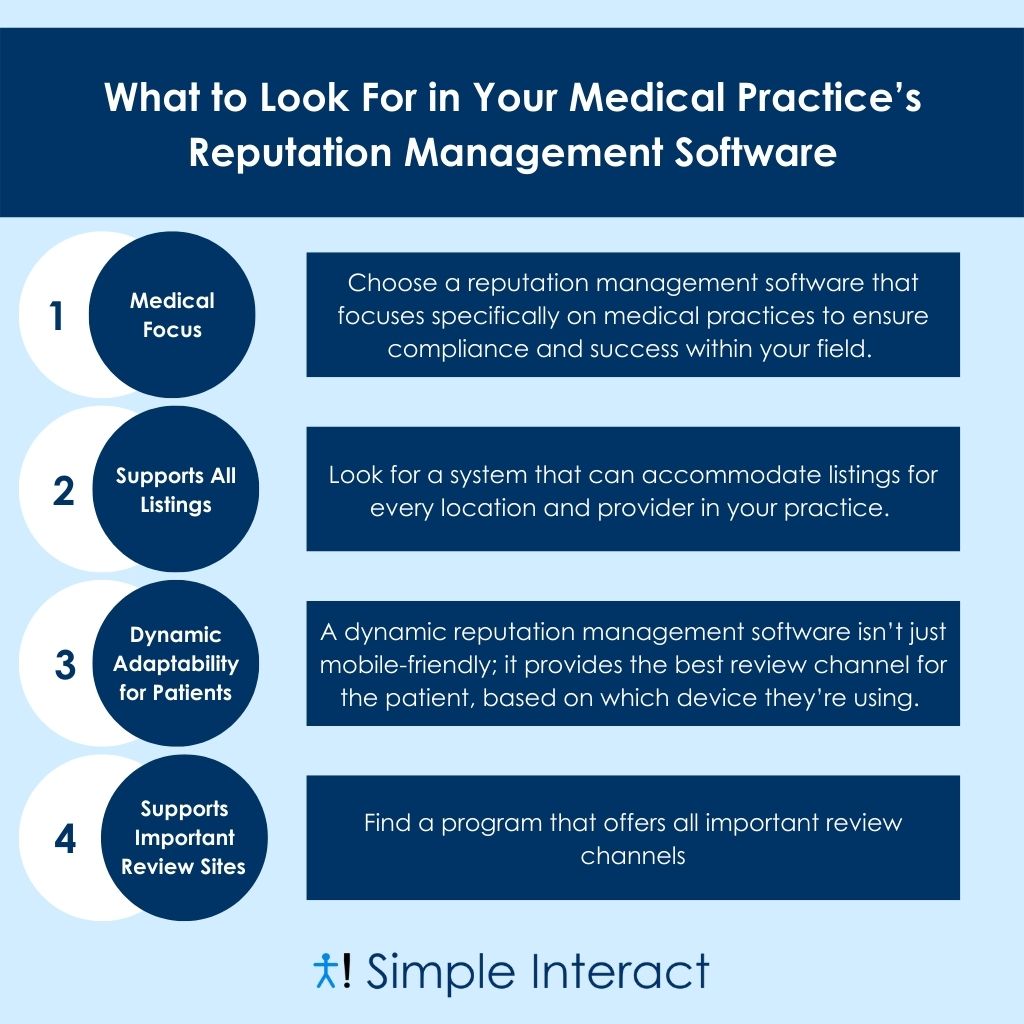4 Things to Consider Before Choosing Reputation Management Software for Your Medical Practice

Quick Read
Summary is AI-generated, 4 Things to Consider Before Choosing Reputation Management Software for Your Medical Practice -reviewed

This blog explains why online reputation is vital for medical practices (and individual providers) and outlines how to manage it effectively.
It emphasises two levels of reputation: practice-level (overall facility/brand) and provider-level (each clinician). If a practice has few reviews or mostly negative ones, prospective patients may choose elsewhere; likewise for a specific provider with poor reviews. The blog recommends targeting the practice listing first, then provider listings. It also provides practical advice—such as limiting review-request options to two platforms at a time (so patients are not overwhelmed) and using software that easily switches review destinations. The piece helps practices understand what to look for in a reputation-management solution and why consistent, proactive review-cultivation matters. In short: online reputation isn’t optional—it’s a growth and retention lever in today’s digital patient-journey ecosystem.
Reviews for healthcare practices are critical for attracting new patients. When a new patient begins researching where to receive care, the first step is often checking online reviews.
A recent study revealed that 75% of U.S. adults review ratings of healthcare providers before visiting, and 72% only consider locations with ratings of four stars or more.
Patients want social proof, whether they’re choosing a restaurant, a business, or a healthcare provider. Positive reviews reassure them that others had a good experience before entrusting their care to a new provider.
This occurs on two levels: the practice level and the provider level. Let’s explore how reputation management matters for both your medical practice and individual providers.
Improve Both Practice and Provider Reputations
If your practice lacks reviews—or if the majority are negative—new patients are less likely to visit. Similarly, if a specific provider has few or poor reviews, patients may look elsewhere. Both scenarios hinder growth.
Patients usually start by reviewing the practice’s overall rating. If it isn’t appealing, they may never check individual provider ratings. Start by improving your practice reputation first to make faster progress.
For multi-location practices, each location may have its own Google or Nextdoor listing, while your Facebook page might represent the practice as a whole. Focus on one or two listings at a time. Once practice listings are optimized, shift attention to improving provider-specific reputations.
(Good reputation management software allows you to quickly change which review options you present to patients.)
Limit review options to two at a time. Offering too many platforms can overwhelm patients, resulting in no reviews submitted.
Which two should you offer? Focus on the platforms that matter most to your practice. Are more patients likely to see your Google listing or Facebook page? Start there, then expand when ready.
For individual providers, ensure each physician has a profile on top review sites like Healthgrades and WebMD. Focus on improving these first. Concentrated efforts yield faster results.
Once all listings are optimized, you can expand review options. Patients could then have one platform requiring login (like Google or Facebook) and one without login (like Healthgrades).
What to Look for in Reputation Management Software for Medical Practices
Reputation management software simplifies the process of collecting and responding to patient reviews, freeing up your team to focus on patient care.
Here are four key elements to look for in medical-focused reputation management software:

1. Medical Focus
Some reputation management programs serve all types of businesses. The medical field has unique regulations, privacy concerns, and niche review sites.
Choose software designed specifically for medical practices and hospitals to ensure compliance and success.
2. Supports All Listings
Software should manage all locations and provider profiles in one place.
Ensure your system supports every location and provider listing in your practice.
3. Dynamic Adaptability to Patients
Mobile-friendly software should also adapt the review channel based on the patient’s device.
Dynamic platforms can adjust for iPhone, Android, or desktop users, making the review process seamless.
4. Supports Important Review Sites
Not all review sites hold equal weight. Patients trust some platforms more than others.
Choose software that supports all major review sites, like Google, Facebook, Healthgrades, and WebMD.
Best Practices of Reputation Management for Medical Practices
Once you select your reputation management software, follow these best practices to maximize results:
- Collect and verify patient contact information. Surveys can’t reach patients you can’t contact.
- Set expectations and explain the why. Let patients know they’ll receive surveys to improve care and that their feedback is valued.
- Train staff to ask for feedback. Scripts help checkout staff encourage patients to complete surveys.
- Track participation rates. If below 20%, implement strategies to increase response rates.
- Monitor negative feedback. Address common complaints proactively before they impact your reputation.
- Respond to reviews. Patients are more likely to visit practices that actively engage with feedback. Responding shows you care.
- Make the process easy. Keep surveys short and allow quick access to post reviews online.
- Ensure HIPAA compliance. Healthcare-specific software helps maintain regulatory compliance.
Help Review Sites Work for You With Reputation Management Software
Popular review platforms have significant reach, but they rely on patients submitting reviews. Reputation management software simplifies this process, making it easy and stress-free.
Simple Interact provides online reputation management software for medical practices, along with other front-office automation solutions. To learn more, visit our patient feedback and online reviews page.

Ravi Kalidindi is the Founder and CEO of Simple Interact, a leading Front Office Automation company that helps healthcare facilities across the United States run more efficiently and profitably by boosting staff productivity, reducing provider burnout, and elevating the patient experience. Customers view Ravi as a trusted partner who can quickly comprehend business problems and suggest “keep it simple” solutions that are effective and easier to maintain over time.
Recent Posts
- Case Study: 85% Patient Forms Completion with NextGen EMR Integration at The ENT Center of Central Georgia
- 14 Patient Intake Form Templates That Get Results
- Breaking Down Language Barriers: Simple Interact’s 2-Way SMS Chat Now Speaks Your Patient’s Language
- Who Should Fill Your Last-Minute ‘Appointment Available’ Slots?
- 4 Dos and Don’ts of Asking for Patient Reviews